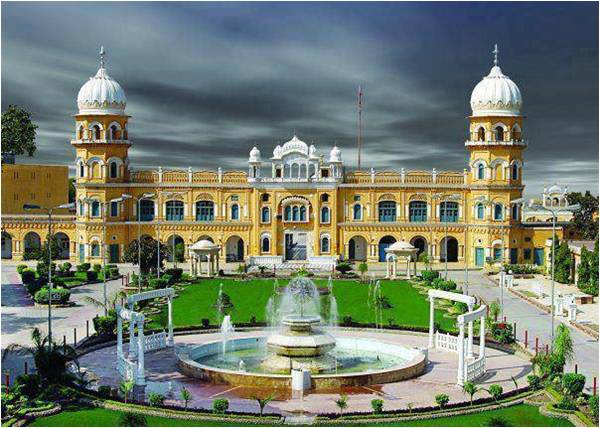
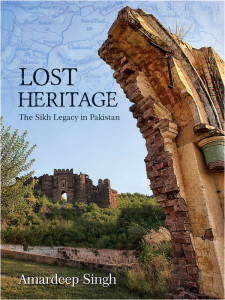
in Pakistan
By Amardeep Singh
New Delhi: The Nagara Trust and Himalayan Books, 2016, 492 pages.
Distributors: http://lostheritagebook.com/
Singapore-based Amardeep Singh has had a successful career in the corporate sector. He was born many years after the partition of India and Punjab in 1947, in Gorakhpur in North India. His father, a goldsmith from Muzaffarabad, Azad Kashmir, had set up his business in that town some years before the partition. He grew up hearing stories from his elders about the lost homeland and Sikh heritage in Pakistan. It comprised much more than the houses and localities left behind: several core landmarks of Sikh religion and political history were located across the border as well. The author visited Pakistan during October 2014.
Returning to one’s roots, personal and spiritual - which were severed irreversibly in 1947 when India, Punjab and Bengal were partitioned - provided him with moments of supreme ecstasy as well as anguish on some occasions. He says in his book that visiting Pakistan became an obsession with him, which he likened to a spiritual calling. This extra-ordinary experience he has documented in a 492-page narrative composed in simple and sincere language and studded with hundreds of stunning photographs. The pictorial saga is a veritable labour of love.
To appreciate his feelings we need to put things in perspective. When the All-India Muslim League demanded the creation of a separate state for Muslims in India, the Sikh leaders immediately retorted that if India were partitioned on a religious basis then the Punjab should also be divided on a similar basis, and the predominantly non-Muslim areas be separated to create a Sikh state or be given to India. From 1940 to 1947, many efforts were made to keep India united but they failed. I have explained in great detail in my book, The Punjab Bloodied, Partitioned and Cleansed the reasons why the three communities of the Punjab - the Hindus, Muslims and Sikhs - failed to agree upon a formula for keeping the Punjab united. In any event, the Punjab was ethnically (or religiously) cleansed so that virtually no Muslim survived in East Punjab (except in the tiny princely state of Malerkotla) and no Hindu or Sikh remained in West Punjab. Amardeep Singh lifts the curtain which was drawn over the Sikh heritage in Pakistan in 1947. Very few Sikhs live in contemporary Pakistan and therefore only a few gurdwaras are maintained in functioning order. The rest are in a state of ruin and dilapidation: some have been converted into mosques while others have become homes to the refugees of 1947. The same is true of educational and charitable institutions left behind.
Guru Arjan invited Muslim saint Hazrat Mian Mir to lay the foundation of the holiest Sikh shrine in the world
The first visit the author paid was to the Dera Sahib Gurdwara located outside the Lahore Fort. Dera Sahib Gurdwara was built to commemorate the martyrdom of the fifth Guru, Arjan Dev, who earned the wrath of the Mughal emperor Jahangir. The author underlines, however, that Guru Arjan believed in the unity of humankind and therefore invited the Muslim saint Hazrat Mian Mir of Lahore to lay the foundation of the holiest Sikh shrine in the world, the Golden Temple. He was pleased to see a religious service going on in Dera Sahib Gurdwara. Some Sikhs and Sindhi Hindus were present and two descendants of Bhai Mardana - the Muslim musician who accompanied Guru Nanak wherever he went - were taking part in the musical performance.
Next he visited the cenotaph of ‘The Lion of Punjab’, Maharaja Ranjit Singh (1799-1839), which is in the same extended compound as Dera Sahib Gurdwara. The pride Sikhs feel in Ranjit Singh’s ascent from a minor local military leader in the Gujranwala tract to the ruler of the Punjab in 1799 (by defeating the Afghans) comes through powerfully in the hagiographical account given by the author. He mentions that the maharajas visited Muslim shrines and mosques and funding to Islamic institutions was given from the state treasury. Muslims were members of the council of ministers and held commanding positions in the army.
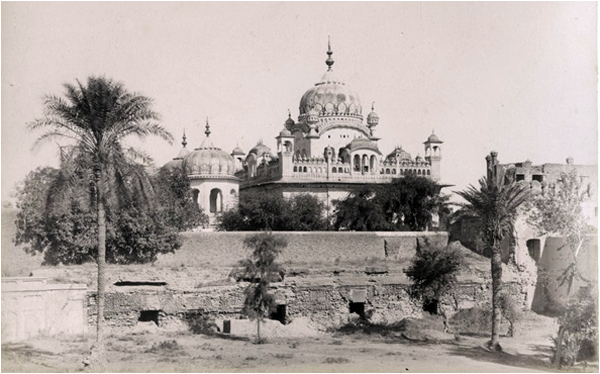
The kingdom disintegrated in less than a decade after the death of Ranjit Singh in 1839. Palace intrigues, coupled with British machinations through the Dogras of Jammu, resulted in the annexation of the Punjab in 1846 by the British. His son Duleep Singh was taken to England where he was raised as a Christian. But later, he recanted and returned to the Sikh faith. His daughter Princess Bamba - born from his marriage to a German woman - returned to Lahore and remained there at the time of Partition. She is buried in the Christian graveyard (Gora Kabiristan) in Lahore. The chapters on Lahore include many other pictures of famous Sikh mansions, educational institutions and of a visit to the Fakir Khana Museum inside Bhaati Gate Lahore - where some rare relics are maintained by the descendants of Ranjit Singh’s foreign minister Fakir Azizuddin. The author also visited the mausoleum of the Sufi Saint Hazrat Mian Mir and the Chevein Pathshahi Gurdwara in Mozang, Lahore, which I have described in detail in my book on the partition of the Punjab. It is only when one sees the photographs that one realises how important Lahore has been in the history and cultural identity of the Sikhs.
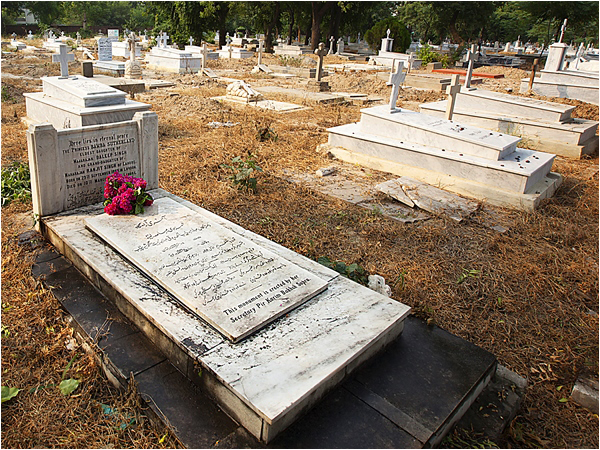
A visit to the shrine of Baba Fariduddin Ganjshakar at Pakpattan in southern Punjab, for a devout Sikh, is also a matter of great importance. This has to be appreciated because Sikhism in an inclusive faith and in the Sikh scriptures, the poetry and legends of Muslim sufis and Hindu sages - celebrating the oneness of humankind - is strongly emphasised. The author emphasised the the secularity and humanism of their messages. I have noticed that in the existing literature on this subject there is some confusion as to whether the verses attributed to Baba Farid are actually his or those of his descendant Shaikh Farid Sani. We learn from the author that Guru Nanak and Shaikh Farid Sani were contemporaries and the former spent some time with the latter. Shaikh Farid Sani recited some verses of Baba Farid to him and that is how - from oral recitation - they were preserved in a written form and included in the Sikh holy book, the Guru Granth Sahib. The author also visited gurdwaras in Sahiwal and Multan in southern Punjab. The pictures from that visit stand out as remarkably expressive of our pluralistic past.
The Sikh legacy is kept alive by Pashtun Sikhs, who were forced to leave Khyber-Pakhtunkhwa after the Taliban arrived
Then he travelled up north to visit Sikh milestones, religious and temporal. Among the most important is Panja Sahib at Hassan Abdal, near Rawalpindi. According to Sikh legend, Baba Nanak rested there on the way back from Baghdad. An impression of his hand is impressed on a boulder which he stopped from falling upon himself. A fabulous gurdwara was built to commemorate it by a famous general of Ranjit Singh, Hari Singh Nalwa. It is one of the shrines included in the officially-permitted pilgrimages of Sikhs to Pakistan. Visits to Peshawar, Jamrud, Abbotabad, Haripur, Manshera, Rawalpindi, Murree, Jhelum and other such places are described in a commentary which touches the heart and the pictures are testimony to the very rich religious and secular heritage of the Sikhs in Pakistan.
Two visits especially deserve special mention. The first was to the author’s hometown of Muzaffarabad in Azad Kashmir. As he entered, he remembered the harrowing story told by his family of how a tribal lashkar (militia) had entered it in October 1947. He writes, “On 22 October over 300 defenceless Sikhs from the surrounding areas were rounded up at Ranbir Singh (Dumel) bridge in Muzaffarabad and executed at point blank range.” Among them were many of his relatives. He writes that when he was planning the trip to Pakistan, he wanted to bring back a handful of soil from Muzaffarabad but when he himself arrived there, he was reminded of the great tragedy that had transpired in 1947. He writes: “I was suddenly left with no desire to explore the valley any further nor [sic] to carry back its soil... I assume that the closure that I had been seeking had taken place with an acceptance that things had changed and I needed to move on.”
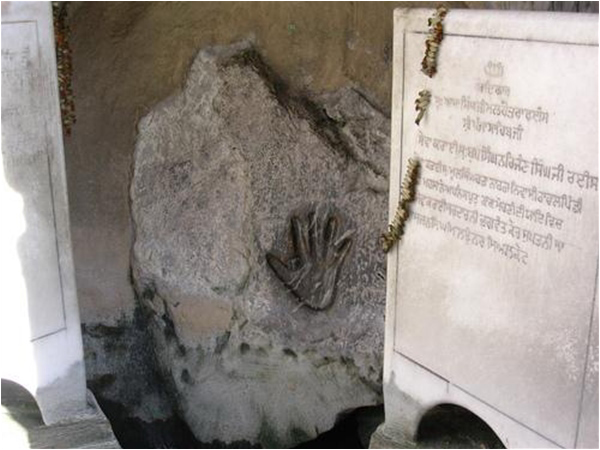
The second visit was the ultimate pilgrimage for Amardeep Singh: to Nankana Sahib in central Punjab, near Sheikhupura. Here the founder of Sikhism - Baba Guru Nanak - was born in 1469. The author found that the religious services and other practices including free food to all were observed fully. We learn how the Sikh legacy is kept alive by a handful of Pashtun Sikhs who were forced to leave their homes and businesses in Khyber-Pakhtunkhwa after the Taliban let loose their reign of terror. At the time of Partition, they were protected by Khan Abdul Ghaffar Khan and that situation remained constant until the Taliban appeared on the political horizon and started imposing their version of Islam. As a result, many Pashtun Sikhs moved to the Punjab where they have set up businesses as well as taken up employment in government services.These Sikh volunteers helped him wherever he went. Some Balochi Hindus displaced from their homes in Dera Bugti had also joined the volunteer corps at the Nankana Sahib Gurdwara.
As always happens when the partition of the Punjab is the backdrop, some stranger-than-fiction true stories from that period always crop up. Thus for example we learn that in 1996 a 28-year old Pakistani, Kaka from Manshera, visited Delhi with the Tablighi Jamaat. His father Isher Singh had wilfully accepted Islam before Partition and was renamed Ghulam Sarwar. A devout Muslim missionary, Kaka nevertheless wanted to re-connect with his Sikh relatives who had migrated to India in 1947. By sheer luck he met someone who directed him to a shop run by Sikhs from Manshera. There he met Amardeep Singh’s cousin Tejpal Singh, who took him home. Tejpal Singh’s grandfather looked at Kaka and said, “He looks like Isher!” Kaka was a splitting image of his father. Kaka raised his hands to thank Allah for His graciousness. A devout Muslim infused with missionary zeal felt emotionally fulfilled by meeting his Sikh relatives. The story did not end at that.
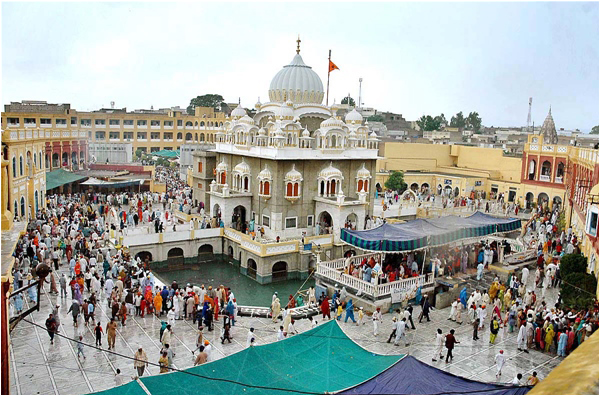
When Kaka was leaving for Pakistan, Tejpal Singh’s father Jaswant Singh told him that his sister Jaswanti had been left behind in Pakistan. Although no information about her was available, he had a feeling she was still alive. Somehow nobody noticed her when the tribal hordes raided Muzaffarabad. A kindly Muslim took her home and raised her as a Muslim. One day in the late 1970s, while visiting Manshera, she noted a shop she had visited as a child. There she met Ghulam Sarwar (formerly Isher Singh) and was very pleased to meet a relative. For two years Kaka kept on looking for some clue of Jaswanti. One day his sister said that it could be Noori whom Ghulam Sarwar (now deceased) had brought home. Kaka now went looking for Noori, who had married a doctor and moved to Rawalpindi. He finally traced her but Noori was hesitant to reopen old wounds and refused to re-connect with her relatives. Kaka then sponsored her brother Jaswant Singh to visit Pakistan. He arrived in 1999 and the brother and sister met finally. This story is nearly identical to that of a Muslim girl (born Azmat Bibi but named Naseeb Kaur by her Sikh protector) who survived a massive slaughter of Muslims in Rupar district of East Punjab, in October 1947. Her mother, who had escaped to Pakistan, finally traced her and they met in 1991. In my book I tell that story too.
I can well imagine the challenge Amardeep Singh faced while writing this classic account of his visit to Pakistan. Muslim-Sikh relations in the past include bitter memories of violent conflict between Muslim rulers and Sikh gurus and later the bloodshed of 1947, but the past also includes rich examples of amity and solidarity. The author writes with grace and without malice. The trip would not have gone anywhere had the Government of Pakistan not given him a visa to travel freely in Pakistan and had the people in Pakistan not been willing to help him. He fully acknowledges that. He especially mentions Shahid Shabbir, Mirza Safdar Baig, Faizan Naqvi, Usman Masaud Tony, Hammad Nasir and Masood Akhtar Janjua, and of course, Kaka. He reserves special thanks for Dr Mimpal Singh, his Pashtun Sikh host in Lahore, who works at the famous Mayo Hospital.
Amardeep Singh has produced a work of exquisite beauty. Even the pictures of derelict gurdwaras, palaces and abandoned localities retain an aesthetical charm that tells the sad story of a bygone era. His study will most certainly become the standard pictorial reference on the Sikh heritage of Pakistan.
Dr Ishtiaq Ahmed is Professor Emeritus of Political Science at Stockholm University and a visiting professor at LUMS, Pakistan. He is also Honorary Senior Fellow at the Institute of South Asian Studies, National University of Singapore

